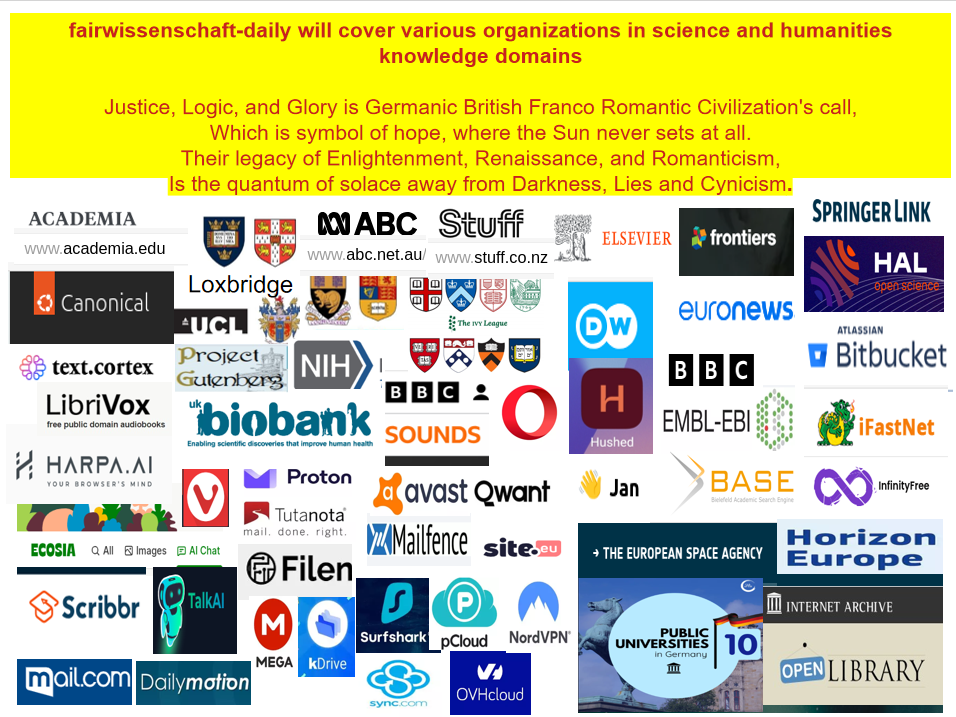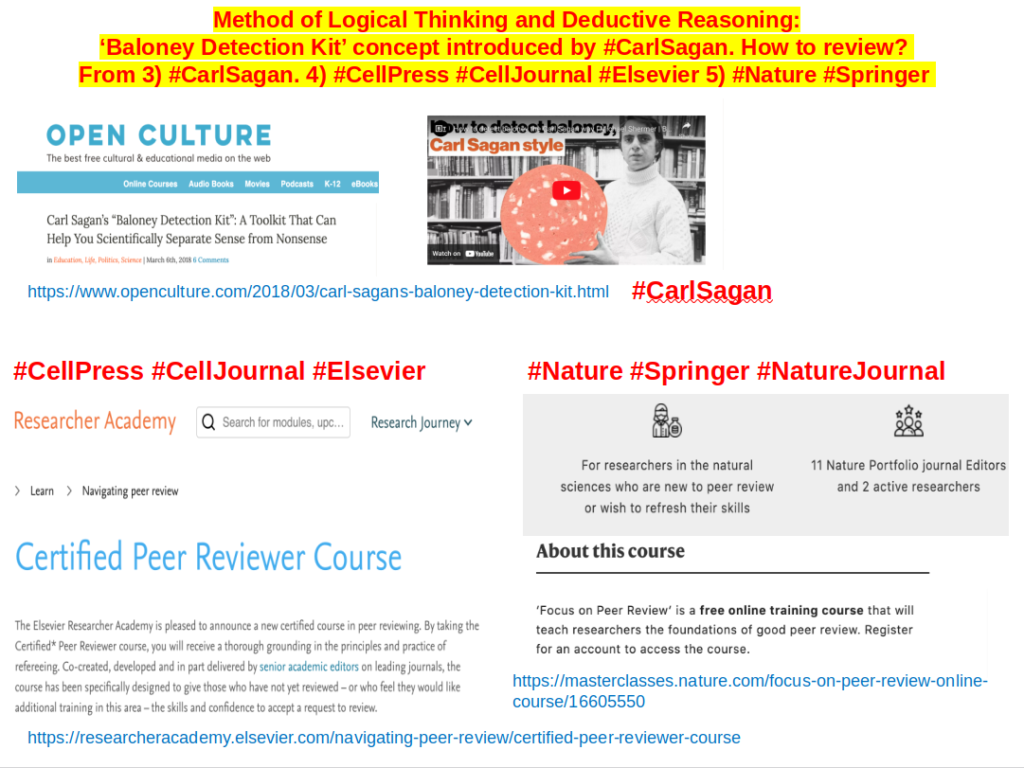Daily
https://fairwissenschaft.co.uk/daily-humanities
https://fairwissenschaft.co.uk/daily-science
fairwissenschaft-daily:
Daily will include NEWS from science and humanities knowledge domains posted by various organizations curated by me. This will include my review of it to capture essence of scientific method and what it means to be a logician in science and humanities. The goal is to satisfy and develop desire to learn and desire to solve problems, referred to as ‘Lernbegierde’ and ‘Problemlösungswunsch’, respectively in German. This exclusive content will be available only on my website, but you are free to share it on social media. Thank you.



From Logical Thinking To Logical Deductions
I appreciate the informative and useful Elsevier Researcher Academy – Certified Peer Reviewer Course offered by #CellPress #CellJournal #Elsevier and #Nature #Springer #NatureJournal has a fantastic peer review course Focus on Peer Review | Nature Masterclasses #Nature #Springer #NatureJournal (see references). These resources greatly benefit a wide range of researchers and reviewers. The on-demand webinars/courses provided by both are invaluable resources for scientific learning. Here’s to continuous growth, learning, and collaboration in the scientific community. Kudos to all the efforts in advancing research and scholarly communication! #ScienceCommunity #ResearchImpact
The courses on scientific review provided by #CellPress #CellJournal #Elsevier and #Nature #Springer #NatureJournal are akin to the “cogito argument” by Rene Descartes, “deductive reasoning” by Sir Arthur Conan Doyle’s Sherlock Holmes and ‘baloney detection kit’ concept introduced by #CarlSagan. Lets me explain their methods.
1. “Cogito Argument” by Rene Descartes
René Descartes, a French philosopher, was born in 1596. He is often credited with being the father of modern philosophy, as well as the father of rationalism. He is perhaps most well-known for his Meditations on First Philosophy, which contains his cogito argument. The cogito argument is “Dubito, ergo Cogito; Cogito ergo Sum (I doubt, therefore I think, I think therefore I am)” by Rene Descartes. Descartes’ cogito argument is based on the premise that he can doubt everything except the fact that he is doubting. He believes that this is a self-evident truth, and that it can be used as a foundation for knowledge. The cogito argument has been influential in the field of epistemology, and has been subject to much debate and discussion. It is considered to be one of the most important contributions to philosophy.
- Doubt everything: Descartes begins by doubting everything, including his own senses and previous knowledge.
- Recognize the existence of thought: He then recognizes that he is thinking, which leads him to the conclusion that thought exists.
- Affirm the existence of the self: From the existence of thought, Descartes asserts the existence of the self.
- Recognize the necessity of the existence of God: He then recognizes that the existence of the self implies the existence of God, who is perfect and cannot deceive.
- Affirm the existence of the external world: Finally, Descartes affirms the existence of the external world, which he perceives through his senses.
2. “Deductive Reasoning” by Sir Arthur Conan Doyle’s Sherlock Holmes
Sherlock Holmes, the world-renowned English detective created by Sir Arthur Conan Doyle, is known for his exceptional skills in deductive reasoning. He is able to solve complex mysteries by using his keen observation skills, inductive reasoning, and logical deductions. Holmes’s method of deduction involves carefully observing the details of a case, making connections between seemingly unrelated facts, and eliminating impossible explanations to arrive at a logical conclusion. His attention to detail and ability to make connections between seemingly unrelated facts is what sets him apart from other detectives. His method of deduction has influenced many fictional and real-life detectives and continues to fascinate readers and audiences worldwide.
- Observation – Sherlock Holmes pays close attention to the details of a case, no matter how seemingly insignificant. He observes everything around him, from the smallest footprints in the snow to the way a person holds themselves.
- Induction – Holmes uses his keen observation skills to draw inferences and make connections between seemingly unrelated facts. He is able to induce a pattern from the observations he makes, which leads him to a hypothesis.
- Deduction – Holmes uses his inductive reasoning to come up with a logical explanation for the observations he has made. He then tests his hypothesis by gathering more evidence and looking for contradictory evidence.
- Elimination – Holmes eliminates any potential explanations that do not fit the evidence. He narrows down his hypothesis to the most likely solution by ruling out the impossible or unlikely ones.
- Conclusion – Holmes reaches a conclusion based on his deductions, eliminations, and observations. He presents his findings to the client or the police, providing a clear and logical explanation for the case.
3. “Baloney Detection Kit” by Carl Sagan
For those unfamiliar with the term, the “baloney detection kit” is a notion brought forth by Carl Sagan in his enlightening book “The Demon-Haunted World: Science as a Candle in the Dark.” Sagan emphasized the significance of critical thinking and skepticism in assessing information. He urged individuals to utilize this metaphorical kit to differentiate between credible scientific claims and pseudoscience or misinformation. It includes tools such as skepticism, logical reasoning, and reliance on scientific evidence to help individuals navigate the vast information landscape. These resources are incredibly valuable for everyone, as they equip us with the skills to think critically about science and become adept ‘baloney detectors’. Here are the steps:
- Extraordinary claims require extraordinary evidence.
- Wherever possible, there should be independent confirmation of the “facts.”
- The source of the evidence should be known, and a record should exist showing how, when, where, and under what circumstances it was obtained.
- The evidence should be reviewed by someone who is not involved in the matter, who is qualified to judge it, and who has no vested interest in the outcome of the investigation.
- If there is any reason to doubt the validity of the evidence, it should be discarded.
- The evidence should be checked to determine whether it might be invalidated by other evidence.
- All reasonable alternatives to the preferred theory should be examined.
- The conclusions should follow logically from the evidence.
- The evidence should be sufficient to justify the conclusions.
- The evidence should be sufficient to convince a reasonable, impartial observer.
Let’s continue fostering a culture of critical thinking, scientific integrity, and insightful research within the scientific community and I hope fairwissenschaft-daily will facilitate this. Here’s to future collaborations and endeavors in advancing knowledge and understanding! #ScienceResearch #ScienceEducation #CriticalThinking
References:
- Researcher Academy – Certified Peer Reviewer Course #CellPress #CellJournal #Elsevier https://researcheracademy.elsevier.com/navigating-peer-review/certified-peer-reviewer-course
- Focus on Peer Review | Nature Masterclasses #Nature #Springer #NatureJournal https://masterclasses.nature.com/focus-on-peer-review-online-course/16605550
- Rene Descartes | Biography, Ideas, Philosophy, ‘I Think, Therefore I Am,’ & Facts | Britannica #britannica https://www.britannica.com/biography/Rene-Descartes
- Rene Descartes – “I think, therefore I am” | BBC | Video | https://www.bbc.co.uk/programmes/p02pdc6n
- Six Metaphysical Meditations by Rene Descartes originally written in Latin and translated to English by William Molyneux | Gutenberg | https://www.gutenberg.org/ebooks/70091
- Six Metaphysical Meditations by Rene Descartes originally written in Latin and translated to English by William Molyneux | Audio | Librivox | https://librivox.org/six-metaphysical-meditations-by-rene-descartes
- Sherlock Holmes by Sir Arthur Conan Doyle | Gutenberg | https://www.gutenberg.org/ebooks/author/69
- Sherlock Holmes by Sir Arthur Conan Doyle | Audio | Librivox | https://librivox.org/author/467
- Tales of Sir Arthur Conan Doyle’s great detective – resident of 221B Baker Street | BBC Radio| https://www.bbc.co.uk/sounds/brand/b01j9gzs
- Think like Sherlock Holmes by Peter Hollins | Creatively Solve Problems, Think with Clarity, Make Insightful Observations & Deductions, and Develop Quick & Accurate Instincts| Internet Archive | https://archive.org/details/peter-hollins-think-like-sherlock/mode/2up
- The complete Sherlock Holmes by Sir Arthur Conan Doyle https://sherlock-holm.es/pdf/a4/1-sided
- Carl Sagan;Baloney Detection Kit”: A Toolkit That Can Help You Scientifically Separate Sense from Nonsense | Open Culture | InternetArchive https://www.openculture.com/2018/03/carl-sagans-baloney-detection-kit.html